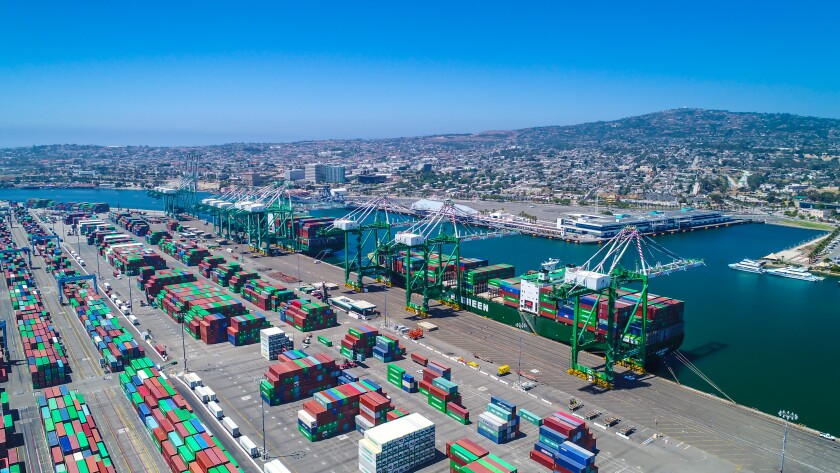In Brief:
Are supply chains more capable of absorbing and responding to disruptions than they were before the COVID-19 pandemic? The question is newly relevant amid the closure of the Port of Baltimore following the collapse of the Francis Scott Key Bridge.
Many big retailers and supply chain managers made changes in response to the pandemic and a series of disruptions in recent years. That includes things like stockpiling extra inventory or sourcing components closer to home. But even small disruptions — let alone the closure of a major U.S. port — can have cascading effects in the global circulation of products and components.
Every disruption is different. But recent experience with business shutdowns and transportation delays could help companies and shippers adjust more quickly to the Baltimore closure, as well as future shocks. “We have experience now in understanding supply chain disruptions,” John Lawler, the chief financial officer at Ford Motor Company, told Bloomberg earlier this week, “so we’ll put that experience to work.”
Although it’s not the biggest port in the U.S. or on the East Coast, the Port of Baltimore is one of the most important links in the national supply chain network, particularly for automobiles, coal, sugar and other imports and exports. The port won’t be reopened at least until the debris from the bridge and the barge that struck it are cleared from the Patapsco River. That could happen in a matter of weeks or months, according to local reports. At least six people are presumed dead due to the collision.
The bridge will take much longer to replace, even with vows from the Biden administration to bring federal attention and funding to the project. Losing a portion of Interstate 695 for years would require adjustments for local commuters as well as for shipping companies — many of which began immediately after the bridge collapsed.
Mitigating Risks
The supply chain is a distributed network; no one’s in charge of making sure it all runs smoothly. Still, individual actors within the system — including corporations, suppliers, shippers and port managers — have developed an evolving set of best practices for dealing with the risk of disruptions. This is mainly related to mitigation by building in redundancies, or having multiple suppliers in different places.
The pandemic, which led to work stoppages and slowdowns at ports and factories around the world, overwhelmed many of those measures. “These best practices unfortunately have been tested many times, not just during COVID but as long as I’ve been researching this area,” said Volodymyr Babich, who studies supply chain management at Georgetown University. “COVID was a terrible shock — and at the same, it has raised awareness at the companies of how vulnerable they are.”
Companies are under constant pressure to reduce costs and mitigating risk tends to be expensive. In the years leading up to the pandemic, many companies tried to make their supply chains as lean as possible to avoid overspending. Many also adopted “just-in-time” logistics techniques to have supplies delivered at the moment when they were most needed.
“This emphasis on lean logistics and squeezing as much capacity utilization as you can get was the name of the game, but in so doing, you remove slack capacity,” says Paul Kent, a senior vice president at Monument Economics Group who consults on port logistics and management. “You need that flexibility because there are many disruptions in the supply chain.”
In the years since the pandemic began, some of that additional capacity has been restored. For ports and warehouses, that means not maxing out space with day-to-day operations, so that disruptions can be managed as they occur. The pandemic has left many companies and shippers still on their toes. “The memory is still fresh enough that they still know what alternatives they have,” Babich says. “They know how to roll with the punches and anticipate bottlenecks.”

(Luis Sinco/TNS)
Shipping Seesaw
West Coast ports had been handling most shipping traffic in the years leading up to the pandemic, Kent says. But many shippers began favoring East Coast ports in the last few years. That’s partly because of big COVID-related delays in places like Los Angeles, but also because of expanded capacity on the East Coast.
Many eastern ports invested money in expanding operations in the decade before the pandemic, making them more attractive to international shippers. Some of that expansion has been aided by public investments. More recently, the Biden administration announced $450 million in new investments in port infrastructure.
But the pendulum could swing back to the West Coast just as easily. Drought conditions have lowered water levels in the Panama Canal and forced shippers to unload some cargo to railroads, causing delays there. Attacks on ships in the Red Sea have caused blockages there as well. Both those factors could make shipping to the West Coast more appealing, Kent says.
The local impacts of the Port of Baltimore closure, and the loss of the Key Bridge, will be much more intense, Kent says. Shippers are sending cargo that was destined for Baltimore to nearby cities until the port can be reopened. Even after that happens, ground transportation to and from the port will be complicated for years to come.
“Baltimore — and not just the Port of Baltimore but everyone in the logistics industry there," Kent says, "will have to exert effort to reclaim Baltimore as the logical place to handle the traffic that is being diverted today."












